Caring for
Antique Dolls
by Bob Brooke
NOTE: Some of the images on this page
may be too horrific for young eyes.
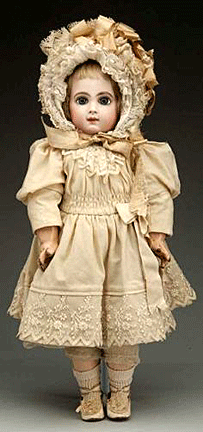 Little
girls love to play with dolls. Many have a favorite that gets loved so
much it literally falls apart. Some adult women also like dolls, but to
them they’re a cherished collectible. More than any other antique,
people wrap dolls in an aura of nostalgia. Thoughts of the little girls
who treasured them in years gone by, or of colonial ladies eagerly
noting details from a new French fashion doll surround such collections
with sentiment. And often that sentiment gets in the way of common sense
when it comes to caring for the dolls in a collection. Little
girls love to play with dolls. Many have a favorite that gets loved so
much it literally falls apart. Some adult women also like dolls, but to
them they’re a cherished collectible. More than any other antique,
people wrap dolls in an aura of nostalgia. Thoughts of the little girls
who treasured them in years gone by, or of colonial ladies eagerly
noting details from a new French fashion doll surround such collections
with sentiment. And often that sentiment gets in the way of common sense
when it comes to caring for the dolls in a collection.
It doesn’t take much to start a doll collection, but over time that
collection can become run down and dirty. So how to you keep the dolls
in your collection looking fresh?
The prime rule for the care of dolls is to preserve them as they are,
rather than trying to restore them to their original perfection. Never
repaint. Generally, it’s better to have a doll that is dingy or
incomplete rather than risk ruining it by overenthusiastic cleaning.
Original paint may easily be scrubbed off a doll's face, except that on
the face of porcelain dolls which is baked on. Although the color is
baked on a porcelain doll, it’s often not well baked. And the makers of
papier-mache dolls paint them with water-based paints.
Cleaning Your Antique Dolls
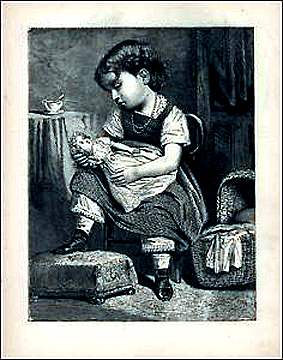 Dirt
is the worst culprit when it comes to dolls. Perhaps you have your dolls
displayed on open shelves. While they don’t look dirty from a glance, up
close you can see that they’re covered in fine dust particles. If at all
possible, keep your dolls in closed cabinets where the dust won’t
accumulate as quickly and cause damage to your precious collectibles.
But if you have to display some or all of your dolls in the open, you
need to dust them regularly. To remove dust from dolls, regularly dust
them with a feather duster or a large soft paint brush. Dirt
is the worst culprit when it comes to dolls. Perhaps you have your dolls
displayed on open shelves. While they don’t look dirty from a glance, up
close you can see that they’re covered in fine dust particles. If at all
possible, keep your dolls in closed cabinets where the dust won’t
accumulate as quickly and cause damage to your precious collectibles.
But if you have to display some or all of your dolls in the open, you
need to dust them regularly. To remove dust from dolls, regularly dust
them with a feather duster or a large soft paint brush.
Dolls basically come in two general types—cloth dolls and porcelain
dolls. First, let’s look at how to clean a cloth doll.
While you should dust your cloth dolls regularly, you will also have to
wash them occasionally. Wash the doll with a clean washcloth that you’ve
rung out to make it wet but not dripping. Use a mild soap or dish
detergent. After you’ve carefully washed your cloth doll, hang it or lay
it flat on a towel to dry to avoid shrinking or damaging the doll's
delicate parts. If you think that your doll is sturdy enough to wash in
your washing machine, toss it in on the gentle cycle (short cycle on
some washing machines) with a small towel and wash in cold water with
liquid laundry detergent. You may want to wash several dolls at the same
time using only a half-load of water. Go easy on the detergent.
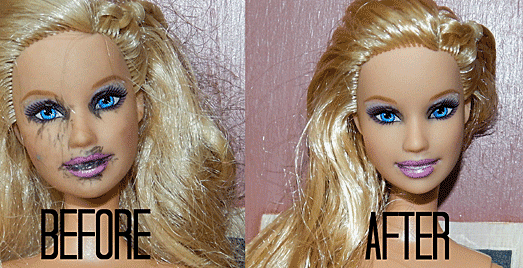
Cleaning a porcelain doll can be a little tricky. First, dust your doll,
then wipe its porcelain parts with a dry cloth. Remove any stains on the
porcelain using a damp soft cloth, but don’t rub too hard because you
could damage the finish, especially if the doll is old. Finally, you’ll
need to wash your doll’s hair.
Chlorine bleaches are also likely to be damaging, and many porcelain
French lady dolls have permanent marks on their cheeks where overzealous
collectors have used abrasives to clean them.
 Washing
a doll's clothes is, if anything, more hazardous than washing its face.
Sulphur dioxide is a common air pollutant that may be clinging to a
dress. Putting the dress in water creates sulphuric acid, leaving the
dress in shreds. Washing
a doll's clothes is, if anything, more hazardous than washing its face.
Sulphur dioxide is a common air pollutant that may be clinging to a
dress. Putting the dress in water creates sulphuric acid, leaving the
dress in shreds.
To wash a doll’s hair, use baby shampoo. Take care not to get the wig
cap wet. If you get the wig cap wet, put it on the doll immediately or
the cap will shrink. Put aluminum foil and plastic wrap on the doll to
protect it while you wash the hair.
When caring for the dolls in your collection, it’s important to protect
the value and integrity of each doll. Any restoration done to a doll is
for preservation. As with all antiques, you should be careful how much
restoration you give a particular doll, especially if you’ve purchased
it as an investment. If a doll is in bad shape, do what you feel is
necessary to preserve the doll. A careful cleaning may be enough.
For instance, you should definitely do something if oily soot or mold
covers a doll’s dress or when rusty pins attach it to its body. But if
an 1830 doll has handmade pins of the same period, leave them.
If you are unhappy with a doll's dress, don't try to fix it. Just put it
carefully aside—marking it so that you can tell which doll it belongs
to—and make a new dress, consulting museums and encyclopedias for period
styles and using old materials and trim if possible.
Repairing Broken Dolls
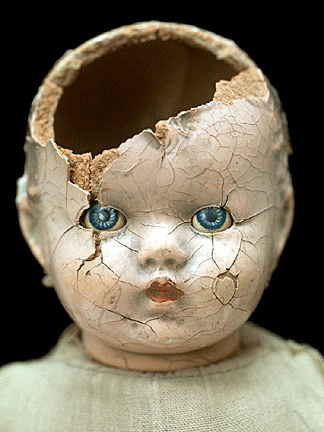 If
a part of one of your porcelain dolls breaks, you can use ordinary white
glue to fix it. After applying a small amount of glue, Press the pieces
together and hold for a few seconds. The crack where the break occurred
will almost disappear if you make sure to line up sides of the break
exactly. Then wipe off the excess glue that oozes through the cracks
using a damp paper towel. Use a piece of blue painter’s tape to hold the
pieces together while the glue dries if necessary. Let the glue dry for
24 hours. You can paint a thin layer of glue on the outside to fill in
cracks. This will dry clear. Paint a couple of layers of glue on the
insides to seal in the pieces and fill in cracks. Be sure to wait for
the glue to dry between coats. If done correctly, your repair will
practically disappear. If
a part of one of your porcelain dolls breaks, you can use ordinary white
glue to fix it. After applying a small amount of glue, Press the pieces
together and hold for a few seconds. The crack where the break occurred
will almost disappear if you make sure to line up sides of the break
exactly. Then wipe off the excess glue that oozes through the cracks
using a damp paper towel. Use a piece of blue painter’s tape to hold the
pieces together while the glue dries if necessary. Let the glue dry for
24 hours. You can paint a thin layer of glue on the outside to fill in
cracks. This will dry clear. Paint a couple of layers of glue on the
insides to seal in the pieces and fill in cracks. Be sure to wait for
the glue to dry between coats. If done correctly, your repair will
practically disappear.
Displaying Your Dolls
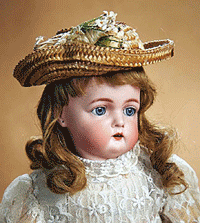 Keep
your doll collection in an environment with a stable temperature and
humidity. Do not place them in bright light, whether natural or
artificial. Incandescent lights are too hot, fluorescent lights cause
chemical reactions, sunlight causes fading, and who knows what the new
light bulbs will do. Serious collectors try to display their dolls in
rooms that are dimly lit. When stored, dolls are usually kept in boxes.
Never store your dolls in plastic bags which encourages moisture through
condensation. Keep
your doll collection in an environment with a stable temperature and
humidity. Do not place them in bright light, whether natural or
artificial. Incandescent lights are too hot, fluorescent lights cause
chemical reactions, sunlight causes fading, and who knows what the new
light bulbs will do. Serious collectors try to display their dolls in
rooms that are dimly lit. When stored, dolls are usually kept in boxes.
Never store your dolls in plastic bags which encourages moisture through
condensation.
One last precaution when caring for your doll collection. Never display
your dolls in direct sun, even for a short while. Put them somewhere in
your home where the sun doesn’t shine directly.
|
DOLL CARE KIT
To make it easier to care for your antique dolls, you might want to
assemble your own Doll Care Kit. The items below are just a suggestion,
but you can add others that you feel are necessary. Creating a kit will
make caring for your antique dolls simple and efficient.
An old toothbrush–the softer the better.
Cotton swabs
A comb
A small hair brush
A soft face towel on which to lay your doll while
you clean it.
An old cotton T-shirt or an old white crew sock
to use as a polishing cloth.
A pair of small scissors to trim threads from
clothing and loose hairs.
Glass jars with lids in which to wash doll
clothes.
A new large soft paint brush.
A small bottle of dish detergent.
Large diameter drinking straws cut into sections
to use as hair curlers. |
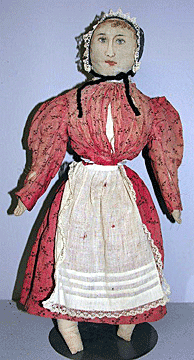 |
<
Back to Caring for Your Collections
Archives
Next Article > |
